Search results for: 'form'
-
 Minoische Votivfigur in Form eines Hundes
Minoische Votivfigur in Form eines HundesStehender Hund, der Kopf nach vorne gereckt, nach oben stehende Ohren. Orangefarbener Ton mit Resten eines roten Überzugs. Sehr gute Erhaltung.
Price: on request Ägyptische Gussform aus der Amarna-Zeit
Ägyptische Gussform aus der Amarna-ZeitGussform aus Terrakotta, für ein Amulett in Form eines Blütenblatts. 18. bis 19. Dynastie, 1600 v. Chr. bis 1100 v. Chr., Altes Ägypten.
Price: on request Scarab with hieroglyphic formula
Scarab with hieroglyphic formulaThe piece is from the Second Intermediate Period. It was probably meant as a good fortune or protective amulet.
Price: on request Scarab with magic formula
Scarab with magic formulaThe stamp shows the anra formula in a cartouche. The amulet should thus serve a magic or ritual purpose for its owner.
Price: on request Scarab with protective formula
Scarab with protective formulaAmulet for protection. Stilized lotus flowers on the upper side. Magic formula on the lower side. This scarab is described in the catalogue of Irène Gautier-Vodoz.
Price: on request ungewöhnlich geformte kanaanitische Öllampe
ungewöhnlich geformte kanaanitische Öllampe1500 v.Chr. bis 1000 v.Chr., vereint Merkmale der späten Bronzezeit und der Eisenzeit I, sehr flach mit hoher Dochtmulde, runder Boden, kein Randkranz.
Price: on request Old Babylonian cuneiform tablet
Old Babylonian cuneiform tabletVery nicely preserved clay tablet with cuneiform legal text from Old Babylonian times.
Price: on request Old Babylonian cuneiform tablet
Old Babylonian cuneiform tabletVery nicely preserved clay tablet with cuneiform administrative text from Old Babylonian times.
Price: on request Old Babylonian cuneiform tablet
Old Babylonian cuneiform tabletLarge clay tablet with cuneiform administrative text from Ur III to Old Babylonian times.
Price: on request Old Babylonian cylinder seal with cuneiform inscription
Old Babylonian cylinder seal with cuneiform inscriptionWorship scene for a god. Mention of moon god Sîn and Aya, wife to the sun god, in the inscription. 1900 to 1600 BC.
Price: on request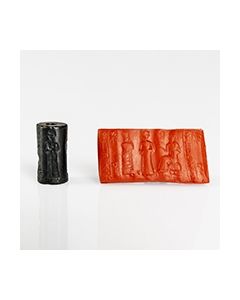 Old Babylonian cylinder seal with cuneiform inscription
Old Babylonian cylinder seal with cuneiform inscriptionWorship scene for a god. Mention of the Babylonian gods of storm, moon and sun in the inscription.
Price: on request Clay tablet with cuneiform text
Clay tablet with cuneiform textSmall cuneiform writing tablet with well preserved text on both sides.
Price: on request Mesopotamian cuneiform tablet
Mesopotamian cuneiform tabletSmall clay tablet with well preserved Sumerian cuneiform writing. From Mesopotamia, probably from Uruk.
Price: on request Cowroid with magical anra formula
Cowroid with magical anra formulaThe bottom side hieroglyphs of the anra type are to be interpreted as magical formula. The amulet dates to the Second Intermediate Period of ancient Egpyt.
Price: on request Cuneiform tablet from Umma
Cuneiform tablet from UmmaRecord of beer and bread rations for laborers. Probably from the Bronze Age city of Umma. The cuneiform tablet was studied and conserved at Yale University.
Price: on request Clay tablet with cuneiform script
Clay tablet with cuneiform scriptSmall tablet with well preserved cuneiform engravings. Interesting Bronze Age document from Mesopotamia.
Price: on request Sumerian cuneiform clay tablet
Sumerian cuneiform clay tabletSmall tablet with drill hole. Cuneiform receipt for bricks or pottery. Very well preserved piece from the late 3rd millenium BC.
Price: on request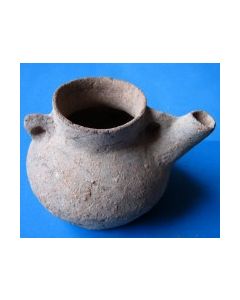 Bronzezeitliche Teekanne, Kugelform
Bronzezeitliche Teekanne, Kugelform2250 bis 1800 v. Chr., Mittlere Bronzezeit I/IIA. Perfekter Zustand, nicht restauriert. Äußerst seltenes Bindeglied zur MBII Epoche. Breiteste Stelle 120mm, Höhe 100mm.
Price: on request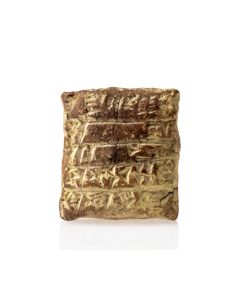 Sumerian cuneiform tablet
Sumerian cuneiform tabletThe clay tablet is a receipt of sheep and goats from the Sumerian city of Puzrish-Dagan. It was made during the reign of King Shu-Sin, 2037 to 2029 BC. From the Yale University Collection.
Price: on request Clay tablet with cuneiform text
Clay tablet with cuneiform textSmall cuneiform writing tablet with well preserved text on both sides.
Price: on request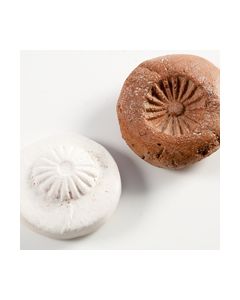 Egyptian amulet mould from the Amarna period
Egyptian amulet mould from the Amarna periodGussform aus Terrakotta, für ein Amulett in Form eines Blütenblatts. 18. bis 19. Dynastie, 1600 v. Chr. bis 1100 v. Chr., Altes Ägypten.
Price: on request Egyptian amulet mould from the Amarna period
Egyptian amulet mould from the Amarna periodGussform aus Terrakotta, für ein Amulett in Form eines Blütenblatts. 18. bis 19. Dynastie, 1600 v. Chr. bis 1100 v. Chr., Altes Ägypten.
Price: on request Skaraboides Stempelsiegel
Skaraboides StempelsiegelÄgyptisches Stempelsiegel-Amulett in der stark stilisierten Form eines Skarabäuskäfers. Die Stempelfläche trägt eine symbolische Verzierung. 1. Jt. v. Chr.
Price: on request Ägyptisches Skarabäusamulett aus der 18. Dynastie
Ägyptisches Skarabäusamulett aus der 18. DynastieÄgyptisches Stempelsiegel-Amulett in der stilisierten Form eines Skarabäuskäfers. Die Stempelfläche trägt Hieroglyphen. Das Amulett datiert in die 18. Dynastie des Alten Ägyptens.
Price: on request Einhenkliger Keramikkrug aus dem Nahen Osten
Einhenkliger Keramikkrug aus dem Nahen OstenDer Körper in Form eines Granatapfels, unten zu einem Standfuß abgeflacht. Hellorangefarbene Keramik. Fund von der Levante.
Price: on request Öllampe der Indus-Kultur - selten
Öllampe der Indus-Kultur - seltenFlache tropfenförmige Öllampe mit breiter Standfläche. Auf einer Drehscheibe gefertigt, dann von Hand in endgültige Form gebracht.
Price: on request großer sumerischer Anhänger aus Stein
großer sumerischer Anhänger aus Steinlänglicher Anhänger, Länge 75mm, Breite 13mm, Höhe 7mm. Mit einem 4mm großen Loch, ca. 3000 v. Chr., perfekte Erhaltung, aufwändig zu einer symmetrischen Form gearbeitet.
Price: on request Ägyptische Siegelfigur der Ersten Zwischenzeit
Ägyptische Siegelfigur der Ersten ZwischenzeitStempel in Form einer sitzenden Frau mit vier geometrischen Mäandermotiven. 7. bis 11. Dynastie des Alten Ägypten. Museumswürdig.
Price: on request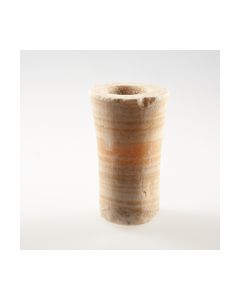 Baktrisches Alabastergefäß für kultische Zwecke
Baktrisches Alabastergefäß für kultische ZweckeSäulenartige Form, öffnet sich leicht zur Oberseite hin. In diese ist eine Mulde eingelassen. Das Gefäß ähnelt in seiner Form den baktrischen Säulenidolen.
Price: on request Henkelkrug aus der Mittleren Bronzezeit
Henkelkrug aus der Mittleren BronzezeitTypische Keramik für den Nahen Osten, die Form weist Parallelen zur sogennanten Tell el-Yahudiyeh Keramik auf. Etwa 2000 v. Chr. bis 1550 v. Chr. Exzellent erhalten.
Price: on request Clay rattle shaped as a bird from the Lusatian culture
Clay rattle shaped as a bird from the Lusatian cultureRassel in Form eines Hauses. Aus dem Übergang der Späten Bronzezeit zur Frühen Eisenzeit Nordmittel-Europas. 1300 bis 500 v. Chr.
Price: on request Seltene Hausurne der Lausitzer-Kultur
Seltene Hausurne der Lausitzer-KulturGroßes Urnengefäß in Form eines Hauses. Aus dem Übergang der Späten Bronzezeit zur Frühen Eisenzeit Nordmittel-Europas. 1300 bis 500 v. Chr.
Price: on request Egyptian Eye of Horus
Egyptian Eye of HorusSmall amulet in form of the Eye of Horus. Popular type of protective amulet from Ancient Egypt.
Price: on request Egyptian Eye of Horus, New Kingdom
Egyptian Eye of Horus, New KingdomSmall amulet in form of the Eye of Horus. Popular type of protective amulet from Ancient Egypt.
Price: on request Dunkelrote Öllampe der Indus-Kultur - selten
Dunkelrote Öllampe der Indus-Kultur - seltenFlache tropfenförmige Öllampe mit breiter Standfläche. Auf einer Drehscheibe gefertigt, dann von Hand in endgültige Form gebracht.
Price: on request Seltenes Gefäß aus der Bronzezeit
Seltenes Gefäß aus der BronzezeitSehr fein gearbeiteter bronzezeitlicher Becher aus roter Keramik, Höhe 9 cm.
Price: on request

